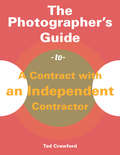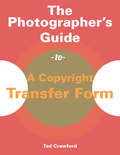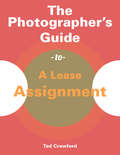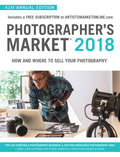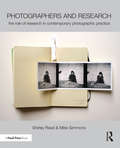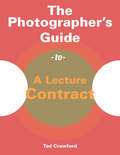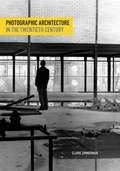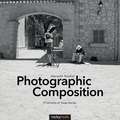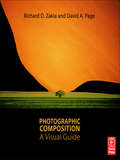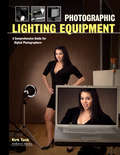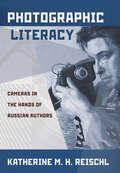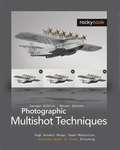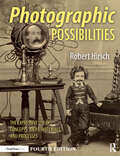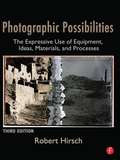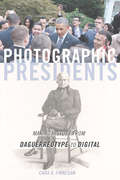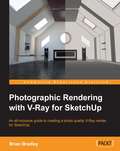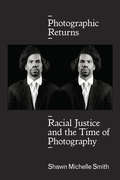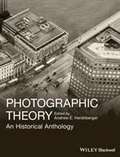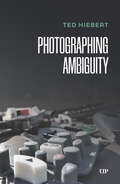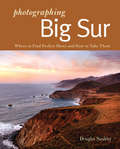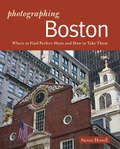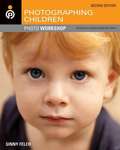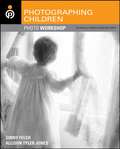- Table View
- List View
Photographer's Guide to a Contract with an Independent Contractor
by Tad CrawfordPart of The Photographer's Guide series, this guide includes information about the issues relevant to photographers today. Hiring an independent contractor-which is different from hiring an employee-requires alternate paperwork. This guide details important employee benefits, payroll taxes, and business expenses a photographer should know before hiring an independent contractor. Included are a helpful negotiation checklist and a sample contract.
Photographer's Guide to a Copyright Transfer Form
by Tad CrawfordPart of The Photographer's Guide series, this guide provides information about the issues relevant to photographers today. Learn about the basic parts of a copyright transfer form while completing a negotiation checklist and consulting a sample transfer form.
Photographer's Guide to a Lease Assignment
by Tad CrawfordPart of The Photographer's Guide series, this guide provides information about the issues relevant to photographers today. It explains the importance of picking an appropriate location for one's work space, whether it is a home studio for a small business or a rented space for a larger business. This guide includes a sample lease agreement as well as list of negotiation tactics, different types of leases, and varying legal forms for artists.
Photographer's Market 2018: How And Where To Sell Your Photography (Market #2018)
by Noel RiveraDiscover Powerful Secrets of Successful Photographers Thousands of successful photographers have trusted Photographer's Market as a resource for growing their businesses. This edition contains the most comprehensive and up-to-date market contacts for working professional photographers today: magazines, book publishers, greeting card companies, stock agencies, advertising firms, photo contests, and more. In addition to the more than 1,500 individually verified contacts, 2018 Photographer's Market includes:A free 1-year subscription to ArtistsMarketOnline.com, where you can search industry contacts, track your submissions, get the latest photography news, and much moreUp-to-date information on how to start and run a photography business, including how to find clients, who to contact to submit your photos, what types of photos they need, and how to submit both digital and film imagesMarkets for fine art photographers, including hundreds of galleries and art fairs, magazine and book publishers, contests, and moreInformative articles on business topics, such as maintaining records, customers service, trends in photography, gallery partnerships, and what makes a photo marketableInspiring and informative interviews with successful professionals, including wedding, concept, fashion and magazine photographers
Photographers and Research: The role of research in contemporary photographic practice
by Mike Simmons Shirley ReadThis ground-breaking book situates research at the heart of photographic practice, asking the key question: What does research mean for photographers? Illuminating the nature and scope of research and its practical application to photography, the book explores how research provides a critical framework to help develop awareness, extend subject knowledge, and inform the development of photographic work. The authors consider research as integral to the creative process and, through interviews with leading photographers, explore how photographers have embedded research strategies into their creative practice.
Photographers Guide to a Lecture Contract
by Tad CrawfordPart of The Photographer's Guide series, this guide provides information about the issues relevant to photographers today. As lecturing can be an important source of income for many photographers, this guide can help ensure that everything goes smoothly. It describes specific details such as transportation, necessary materials, cancellation policies, and location, and includes a sample contract and negotiation checklist.
Photographic Architecture in the Twentieth Century
by Claire ZimmermanOne hundred years ago, architects found in the medium of photography—so good at representing a building&’s lines and planes—a necessary way to promote their practices. It soon became apparent, however, that photography did more than reproduce what it depicted. It altered both subject and reception, as architecture in the twentieth century was enlisted as a form of mass communication. Claire Zimmerman reveals how photography profoundly influenced architectural design in the past century, playing an instrumental role in the evolution of modern architecture. Her &“picture anthropology&” demonstrates how buildings changed irrevocably and substantially through their interaction with photography, beginning with the emergence of mass-printed photographically illustrated texts in Germany before World War II and concluding with the postwar age of commercial advertising. In taking up &“photographic architecture,&” Zimmerman considers two interconnected topics: first, architectural photography and its circulation; and second, the impact of photography on architectural design. She describes how architectural photographic protocols developed in Germany in the early twentieth century, expanded significantly in the wartime and postwar diaspora, and accelerated dramatically with the advent of postmodernism. In modern architecture, she argues, how buildings looked and how photographs made them look overlapped in consequential ways. In architecture and photography, the modernist concepts that were visible to the largest number over the widest terrain with the greatest clarity carried the day. This richly illustrated work shows, for the first time, how new ideas and new buildings arose from the interplay of photography and architecture—transforming how we see the world and how we act on it.
Photographic Composition
by Albrecht RisslerAll fine artists share a common goal: to combine individual elements into a convincing, cohesive whole that tells a story or expresses an intention. Photography is especially suited to this pursuit because the photographer can create multiple, distinct images of a single subject using a variety of design techniques. The display on a digital camera instantly shows the arrangement of elements in an image, allowing the photographer to make changes and refine their creation as they work.Albrecht Rissler believes that a firm understanding of image design is as important as having an observant eye or having the technical knowledge to operate a camera. Photographic Composition presents the most important concepts of image design and offers 250 beautiful photographs to illustrate these concepts. By applying these concepts to your own work, you will greatly improve your photographic eye and your ability to compose an ideal image.This book's impressive images are in black-and-white, intentionally removing the distraction of color and making it easy to focus on compositional elements and form. With this book, photographers as well as all visual artists will learn how to infuse their own images with excitement, develop and hone their visual language, and express their personal artistic aesthetic.Topics include:The effect of various aspect ratiosPerspective and compositionForm and contrastProportion and harmonySymmetry and asymmetryBrightness and darknessStructures and texturesThe "perfect moment"
Photographic Composition: A Visual Guide
by Richard D. Zakia David Page"Those of you who follow this blog know that Dr. Richard Zakia, former RIT professor, is one of my all time favorite photo gurus. We send each other pictures. We talk about looking into pictures - and not just looking at them. Big difference.. Dr. Richard Zakia, a.k.a. Dick, is the co-author, along with David Page, of Photographic Composition: A Visual Guide. These two dudes are also two of my favorite people."---Rick Sammon's blog "Covers all the tips needed to help photographers construct their own unique, outstanding images and is an outstanding 'must' for any collection."--CA Bookwatch
Photographic Guide to Longhorned Beetles of Bolivia: Guía Fotográfica de Escarabajos Longicornios de Bolivia
by James Earl Wappes Julieta Ledezma Arias Steven Wayne LingafelterWith loss of habitats throughout the world occurring at a staggering rate, it is critical to document what is being lost. This book strives to do that by focusing on longhorned woodboring beetles in Bolivia. Wholesale clearing of large tracts of land kills everything or forces species to move quickly to other areas, disrupting the balance of the ecosystem. This book will help people discover and appreciate some of the amazing diversity of life that exists in the undeveloped and/or remote natural areas of Bolivia. Nearly 1,900 species of longhorned woodboring beetles (Disteniidae, Vesperidae, and Cerambycidae) are known from Bolivia (with more than 200 species yet to be determined). This work features 500 of them, representing the breadth of morphological evolution.
Photographic Lighting Equipment
by Kirk TuckFrom flashlights and top-of-the-line studio electronic flashes to light stands and battery/inverter packs, this all-encompassing survey evaluates the vast array of lighting and equipment options available to professional photographers. Beginning with a basic history of the role of lighting equipment and the interplay between advances in capture and lighting technologies, the emphasis then shifts to advances made within the past five years that have enabled photographers to consider more low-powered and cost effective options than ever before. In addition to identifying the wide range of gear currently on the market#151;as well as those photographers may devise on their own#151;this reference examines the pros and cons of the various technologies and provides suggestions for their most practical use. Photographs of the equipment surveyed as well as real-life images created with the different pieces of equipment are interspersed throughout the text. Other helpful hints include tips for maximizing versatility, investment in each piece of equipment, and a #147;Top-Ten Must-Have List. ”
Photographic Lighting Simplified
by Susan MccartneyFor aspiring photographers ready to transform their work from average to expert, here is the "bible" to lighting any subject and space effectively. In specific but nontechnical terms, Photographic Lighting Simplified explains how to take light sources-from outdoor bright sunlight to indoor household lighting-and recreate their effects in the studio. A series of enjoyable, hands-on assignments show readers tips for selecting the right camera format, film, and lenses; the basics of metering and testing; overviews of essential equipment for studio lighting; and much more. Plus, dozens of step-by-step illustrations demonstrate an array of techniques for lighting reflective metal and glass objects; lighting different face types and groups; and special lighting considerations for digital cameras. For anyone who is serious about taking better photographs, this is the ultimate success guide.
Photographic Literacy: Cameras in the Hands of Russian Authors
by Katherine M. ReischlPhotography, introduced to Russia in 1839, was nothing short of a sensation. Its rapid proliferation challenged the other arts, including painting and literature, as well as the very integrity of the self. If Leo Tolstoy and Fyodor Dostoevsky greeted the camera with skepticism in the nineteenth century, numerous twentieth-century authors welcomed it with a warm embrace. As Katherine M. H. Reischl shows in Photographic Literacy, authors as varied as Leonid Andreev, Ilya Ehrenburg, and Alexander Solzhenitsyn picked up the camera and reshaped not only their writing practices but also the sphere of literacy itself.For these authors, a single photograph or a photograph as illustration is never an endpoint; their authorial practices continually transform and animate the frozen moment. But just as authors used images to shape the reception of their work and selves, Russian photographers—including Sergei Prokudin-Gorsky and Alexander Rodchenko—used text to shape the reception of their visual work. From the diary to print, the literary word imbues that photographic moment with a personal life story, and frames and reframes it in the writing of history. In this primer on photographic literacy, Reischl argues for the central place that photography has played in the formation of the Russian literary imagination over the course of roughly seventy years. From image to text and back again, she traces the visual consciousness of modern Russian literature as captured through the lens of the Russian author-photographer.
Photographic Multishot Techniques
by Juergen Gulbins Rainer GulbinsPhotographers are just beginning to realize the potential of high dynamic range imaging (HDRI). Now, the newest techniques based on a bracketed series of exposures make it possible to go beyond HDRI: photographers can increase resolution for ultra-sharp, detailed images, and they can extend the depth of field in a way that was never before possible. Photographic Multishot Techniques provides a thorough introduction and is a hands-on guide to these various techniques. Using a series of example images, the authors explain and illustrate the use of each technique. Included are lessons on HDRI, super-resolution, focus stacking, and stitching images. Moreover, the reader will learn how to effectively combine these various techniques to create amazing images. Throughout the book, the authors use tools such as Photoshop, PhotoAcute, Photomatix Pro, FDRTools, CombineZM, DOP Detail Extractor, and Helicon Focus to illustrate the workflow with detailed, step-by-step instructions. Most of these tools offer free trial versions that are available for download at the Rocky Nook Website at the book description of "Photographic Multishot Techniques". Learning to use these cutting-edge techniques is sure to expand the repertoire and improve the photographic skills of the professional, as well as the advanced amateur, photographer.
Photographic Possibilities: The Expressive Use of Concepts, Ideas, Materials, and Processes
by Robert HirschThe long-awaited new edition of this seminal text features clear, reliable, step-by-step instructions on innovative alternative and traditional photographic processes. Over and above a full update and revision of the technical data, there are new sections on digital negative making, electrophotography, and self-publishing. Foremost practioners, including Edward Bateman, Dan Burkholder, Tom Carpenter, Mark Osterman, France Scully Osterman, Jill Skupin Burkholder, Brian Taylor, and Laurie Tümer, have contributed their expertise to this edition. Perfect for practitioners or students of handmade photography, the book covers classic black-and-white film and paper processes, hand-coated processes like Cyanotype, and Platinum/Palladium. Also featured is an enhanced section on gum bichromate, invaluable instruction on workflow, and the integration of digital, promoting the effective union of one’s concepts, materials, and processes. The book showcases work and commentary from more than 150 international artists.
Photographic Possibilities: The Expressive Use of Equipment, Ideas, Materials, and Processes
by Robert HirschPhotographic Possibilities, Third Edition is a marvelously updated resource of innovative and traditional photographic processes that imagemakers have come to trust and depend on to enhance their technical knowledge, create astonishing pictures, and raise their visual consciousness. This concise and reliable handbook provides professional and advanced photography students with practical pathways of utilizing diverse photographic methods to produce engaging, expressive pictures from an informed aesthetic and conceptual position. This update, in full color for this first time, offers new links between analog and digital photography by featuring clear, up-to-date, step-by-step instructions on topics ranging from making ambrotypes and digital negatives to pre-picturemaking activities that utilize a thinking system to visually realize what is in your mind's eye in an effective and safe manner. This edition vividly showcases the thought-provoking work of over 140 international artists including Peter Beard, Dan Burkholder, Carl Chiarenza, Michael Kenna, Dinh Q. Lê, Joe Mills, Andrea Modica, Bea Nettles, France Scully and Mark Osterman, Robert & Shana ParkeHarrison, Holly Roberts, Martha Rosler, Mike and Doug Starn, John Sexton, Brian Taylor, Jerry Uelsmann, and Joel Peter Witkin as well as other major and emerging talents. Image captions explain how each artist technically realized their vision and concept. All technical information and resources have been refreshed to provide the latest data for acquiring the products needed for these processes. Above all, this comprehensive reference provides field-proven know-how, encouragement, inspiration, and a profuse compendium of promising photo-based explorations one can discover and pursue.
Photographic Presidents: Making History from Daguerreotype to Digital
by Cara A. FinneganDefining the Chief Executive via flash powder and selfie sticks Lincoln’s somber portraits. Lyndon Johnson’s swearing in. George W. Bush’s reaction to learning about the 9/11 attacks. Photography plays an indelible role in how we remember and define American presidents. Throughout history, presidents have actively participated in all aspects of photography, not only by sitting for photos but by taking and consuming them. Cara A. Finnegan ventures from a newly-discovered daguerreotype of John Quincy Adams to Barack Obama’s selfies to tell the stories of how presidents have participated in the medium’s transformative moments. As she shows, technological developments not only changed photography, but introduced new visual values that influence how we judge an image. At the same time, presidential photographs—as representations of leaders who symbolized the nation—sparked public debate on these values and their implications. An original journey through political history, Photographic Presidents reveals the intertwined evolution of an American institution and a medium that continues to define it.
Photographic Rendering with V-Ray for SketchUp
by Brian BradleyThis book is filled with examples explaining the theoretical concepts behind them. Filled with ample screenshots, diagrams, and final rendered images, this book will help readers develop an understanding of photographic rendering with V-Ray. If you are a SketchUp user who would love to turn your favourite modelling application into a 'virtual photography studio', then this book has been designed and written for you. Existing V-Ray users will also find plenty to enjoy and benefit from in this book. Some basic experience with SketchUp and familiarity with photography will be helpful, but is not mandatory.
Photographic Returns: Racial Justice and the Time of Photography
by Shawn Michelle SmithIn Photographic Returns Shawn Michelle Smith traces how historical moments of racial crisis come to be known photographically and how the past continues to inhabit, punctuate, and transform the present through the photographic medium in contemporary art. Smith engages photographs by Rashid Johnson, Sally Mann, Deborah Luster, Lorna Simpson, Jason Lazarus, Carrie Mae Weems, Taryn Simon, and Dawoud Bey, among others. Each of these artists turns to the past—whether by using nineteenth-century techniques to produce images or by re-creating iconic historic photographs—as a way to use history to negotiate the present and to call attention to the unfinished political project of racial justice in the United States. By interrogating their use of photography to recall, revise, and amplify the relationship between racial politics of the past and present, Smith locates a temporal recursivity that is intrinsic to photography, in which images return to haunt the viewer and prompt reflection on the present and an imagination of a more just future.
Photographic Theory: An Historical Anthology
by Andrew E. HershbergerThis book presents a compendium of readings spanning ancient times to the digital age that are related to the history, nature, and current status of debates in photographic theory. The book, offers an authoritative and academically up-to-date compendium of the history of photographic theory. Represents the only collection to include ancient, Renaissance, and 19th-, 20th-, and 21st-century writings related to the subject. Stresses the drama of historical and contemporary debates within theoretical circles. Features comprehensive coverage of recent trends in digital photography. Fills a much-needed gap in the existing literature.
Photographing Ambiguity (Digital Futures)
by Ted HiebertPhotographing Ambiguity examines photography as a metaphor for technological culture, arguing that a relational exploration of the medium can shed light on the dominant ideological tendencies of our time. The book advocates for photographic practices that emphasize ambiguity, suggesting that this approach fosters more conscientious, ecological, and creative relationships within the technological ecosystem of contemporary life. Ted Hiebert critiques the notion that images should primarily serve to verify or document the external world. He contends that these quantifiable perspectives, while rooted in historical trends towards technology and data, have become so pervasive that they represent a dominant ideological bias in the twenty-first century. In response to this data-driven consciousness, the book presents a series of exercises designed to cultivate an embodied experience with digital living – not in opposition to the flood of images but within it. Ultimately, Photographing Ambiguity encourages readers to understand photographs not as benchmarks of reality but as ambiguous constructions of our present and future imaginaries.
Photographing Big Sur: Where to Find Perfect Shots and How to Take Them
by Douglas SteakleyAn exciting series that combines wanderlust with the art of photography. The rugged Big Sur coastline is one of the most photogenic in the world. Th e route along Highway 1 dips down to pristine beaches and climbs precariously high above the Pacific, offering sweeping panoramic views. There is also a great variety of wildlife, including gray whales, porpoises, sea lions, and elephant seals. Patient and lucky photographers might also spot endangered California condors riding the thermals. This book describes the best photo locations for novices and professionals alike, beginning with Point Lobos and continuing south to Hearst Castle and San Simeon. Clear directions and detailed maps are here too. Professional photographer Doug Steakley guides you to the right place at the right time of day to get memorable photographs.
Photographing Boston: Where to Find Perfect Shots and How to Take Them
by Steven HowellFrom historic and iconic Beantown bravado to modern skyscrapers and urban scenery and greenery, this guide offers more than 100 Boston photo opportunities. Beginners, avid amateurs, and seasoned pros alike will appreciate the wide array of photography subjects and themes covered in The Photographer’s Guide to Boston. Conveniently and logically organized by neighborhood, you’ll visit the Freedom Trail, the Emerald Necklace, Beacon Hill, the North End, Back Bay, the Fens, and South Boston, along with many other photogenic historic and modern sites. Author Steven Howell has created the perfect photographer’s travel companion.
Photographing Children Photo Workshop, Second Edition
by Ginny FelchCapture the essence of childhood through digital photography with this helpful resource Family photography continues to be a major field of professional digital photography, while amateur moms are the fastest growing segment of digital camera owners. No matter your level of expertise, you'll benefit from the invaluable advice featured in this new edition. Updated with new photos and revised text to cover the latest technologies, this inspirational book offers critical assistance with photographing children in portrait or candid situations, natural environments or structured interiors, and any variety of lighting. You'll find practical techniques as well as artistic guidance to capture a photo that radiates the innocence and magic of childhood. Offers a strong understanding of photography's fundamentals and explains how they are crucial to capturing memorable images of children Covers all the latest equipment and technology including mobile phones and HD video, and details how to capture fantastic images no matter the medium Instructs you on how to effectively photograph children in a variety of situations, lighting, environments, weather, etc. Shares insider advice on how to take frame-worthy photos of children that emanate the magic of childhood Photographing Children Photo Workshop, Second Edition shows you how to sharpen your observation skills and involve your subjects so you can take memorable photos of children that will last for generations.
Photographing Children Photo Workshop: Develop Your Digital Photography Talent (Photo Workshop #5)
by Ginny FelchWhile digital technology has made acceptable photos easy to achieve, this book is about taking exceptional photos that preserve the essence of childhood.You?ll learn to trust your instincts and your own unique vision and discover how to create beautiful photographs in a variety of lighting situations, all while sharpening your observation skills and learning how to involve your subjects. Plus, insightful tips on understanding what equipment is right for you will help you get great results when working with any age group.
